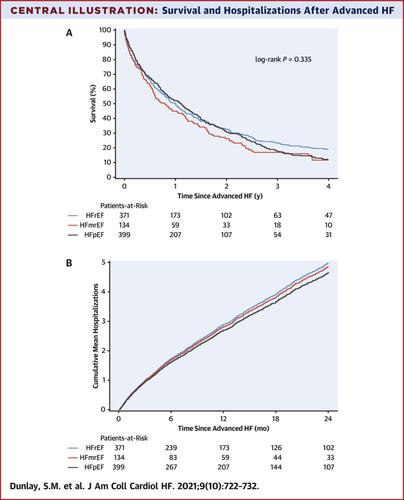JACC: Heart Failure ( IF 10.3 ) Pub Date : 2021-08-11 , DOI: 10.1016/j.jchf.2021.05.009 Shannon M Dunlay 1 , Véronique L Roger 2 , Jill M Killian 3 , Susan A Weston 3 , Philip J Schulte 3 , Anna V Subramaniam 4 , Saul B Blecker 5 , Margaret M Redfield 6

|
Objectives
The goal of this study was to evaluate the prevalence, characteristics, and outcomes of patients with advanced heart failure (HF) in a geographically defined population.
Background
Some patients with HF progress to advanced HF, characterized by debilitating HF symptoms refractory to therapy. Limited data are available on the epidemiology and outcomes of patients with advanced HF.
Methods
This was a population-based cohort study of all Olmsted County, Minnesota, adults with and without HF from 2007 to 2017. The 2018 European Society of Cardiology advanced HF diagnostic criteria were operationalized and applied to all patients with HF. Hospitalization and mortality in advanced HF, overall and according to ejection fraction (EF) type (reduced EF <40% [HFrEF], mid-range EF 40%-49% [HFmrEF], and preserved EF ≥50% [HFpEF]) were examined using Andersen-Gill and Cox models.
Results
Of 6,836 adults with HF, 936 (13.7%) met criteria for advanced HF. The prevalence of advanced HF increased with age and was higher in men. At advanced HF diagnosis, 396 (42.3%) patients had HFrEF, 134 (14.3%) had HFmrEF, and 406 (43.4%) had HFpEF. The median (interquartile range) time from advanced HF diagnosis to death was 12.2 months (3.7-29.9 months). The mean rate of hospitalization was 2.91 (95% CI: 2.78-3.06) per person-year in the first year after advanced HF diagnosis. There were no differences in risks of all-cause mortality or hospitalization by EF. Patients with advanced HFpEF were at lower risk for cardiovascular mortality compared with advanced HFrEF (HR: 0.79; 95% CI: 0.65-0.97).
Conclusions
In this population-based study, more than one-half of patients with advanced HF had mid-range or preserved EF, and survival was poor regardless of EF.
中文翻译:

晚期心力衰竭流行病学和结果
目标
本研究的目的是评估地理定义人群中晚期心力衰竭 (HF) 患者的患病率、特征和结局。
背景
一些心力衰竭患者进展为晚期心力衰竭,其特征是治疗无效的心力衰竭症状。关于晚期 HF 患者的流行病学和结局的数据有限。
方法
这是一项基于人群的队列研究,对象为明尼苏达州奥姆斯特德县所有 2007 年至 2017 年患有和不患有 HF 的成年人。2018 年欧洲心脏病学会高级 HF 诊断标准已实施并适用于所有 HF 患者。晚期 HF 的住院率和死亡率,总体和根据射血分数 (EF) 类型(降低 EF <40% [HFrEF]、中等范围 EF 40%-49% [HFmrEF] 和保留 EF ≥50% [HFpEF])使用 Andersen-Gill 和 Cox 模型检查。
结果
在 6,836 名患有 HF 的成年人中,936 名 (13.7%) 符合晚期 HF 的标准。晚期 HF 的患病率随着年龄的增长而增加,并且在男性中更高。在晚期 HF 诊断中,396 名 (42.3%) 患者患有 HFrEF,134 名 (14.3%) 患有 HFmrEF,406 名 (43.4%) 患有 HFpEF。从晚期 HF 诊断到死亡的中位时间(四分位距)为 12.2 个月(3.7-29.9 个月)。在晚期 HF 诊断后的第一年,平均住院率为 2.91(95% CI:2.78-3.06)/人/年。EF 在全因死亡或住院风险方面没有差异。与晚期 HFrEF 相比,晚期 HFpEF 患者的心血管死亡风险较低(HR:0.79;95% CI:0.65-0.97)。
结论
在这项基于人群的研究中,超过一半的晚期 HF 患者的 EF 处于中等范围或保持不变,无论 EF 如何,生存率都很差。











































 京公网安备 11010802027423号
京公网安备 11010802027423号